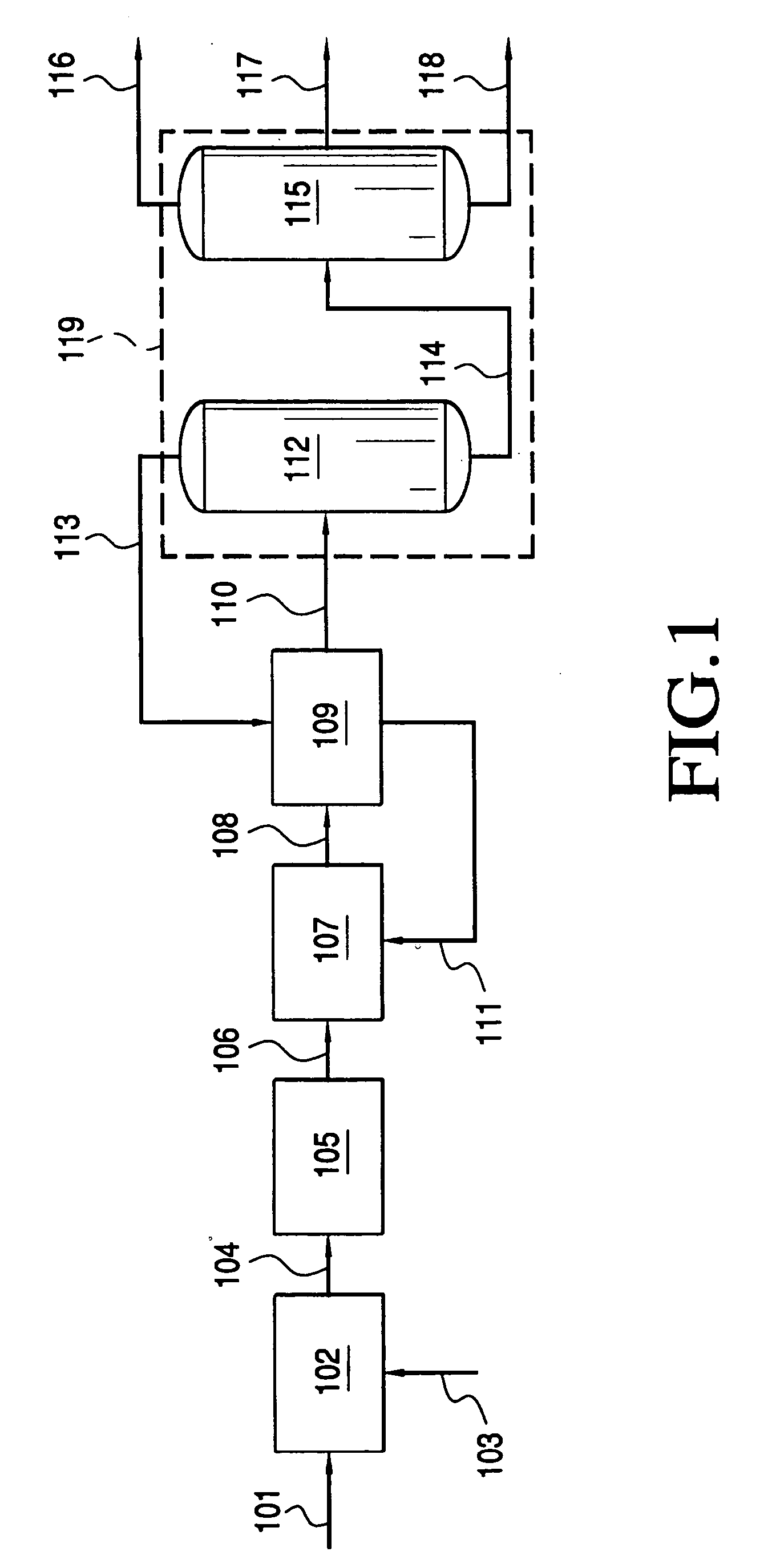[0007] In another embodiment, the invention is to a process for forming light olefins, wherein the process comprises the steps of: (a) contacting syngas with a first catalyst in a first reaction zone under conditions effective to convert the syngas to dimethyl ether, methanol and water; and (b) contacting the dimethyl ether with a second catalyst in a second reaction zone under conditions effective to convert the dimethyl ether to the light olefins and water. Optionally, the process further comprises the step of: (c) separating, prior to step (b), a weight majority of the dimethyl ether and the methanol formed in step (a), from a weight majority of the water formed in step (a). Alternatively, the process further comprises the step of: (c) separating, prior to step (b), a weight majority of the dimethyl ether formed in step (a) from a weight majority of the methanol and water formed in step (a). Optionally, the first catalyst comprises a component selected from the group consisting of: an aluminum phosphate (AlPO4), an acidic γ-alumina, a modified zeolite, mordenite, a zeolite, ZSM-5, sulfonic acid ion exchange resin, a perfluorinated sulfonic acid ionomer, and a copper/zinc oxide combined in a mixture or separate stages. The second catalyst optionally comprises a molecular sieve selected from the group consisting of SAPO-5, SAPO-8, SAPO-11, SAPO-16, SAPO-17, SAPO-18, SAPO-20, SAPO-31, SAPO-34, SAPO-35, SAPO-36, SAPO-37, SAPO-40, SAPO-41, SAPO-42, SAPO-44, SAPO-47, SAPO-56, ZSM-5, metal containing forms thereof, intergrown forms thereof, AEI/CHA intergrowths, and mixtures thereof. The first reaction zone optionally is in a fixed bed reactor, and the second reaction zone optionally is in a fluidized reactor.
[0008] In another embodiment, the invention is to a process for forming light olefins, wherein the process comprises the steps of: (a) contacting methanol with a first catalyst to form a first effluent stream comprising dimethyl ether, methanol, and water; (b) adding a recycle stream, which optionally comprises water, to the first effluent stream to form a combined stream; (c) removing water from the combined stream to form a DME concentrated stream comprising dimethyl ether and methanol; (d) contacting the dimethyl ether from the DME concentrated stream with a second catalyst to form a second effluent stream comprising the light olefins and additional water; and (e) separating the second effluent stream into a product stream and the recycle stream. Optionally, the second effluent stream comprises at least about 22 molar percent, at least about 32 molar percent, or at least about 36 molar percent light olefins, based on the total moles of light olefins and water in the second effluent stream. Step (e) optionally comprises quenching the second effluent stream under conditions effective to form an overhead stream and a bottoms stream, wherein the overhead stream comprises a weight majority of the light olefins, and the bottoms stream comprises a weight majority of the water formed in step (d), wherein the recycle stream comprises at least a portion of the bottoms stream. Alternatively, step (e) comprises: (i) compressing at least a portion of the second effluent stream to form a compressed stream; and (ii) cooling at least a portion of the compressed stream under conditions effective to form an overhead stream and a bottoms stream, wherein the overhead stream comprises a weight majority of the light olefins from the compressed stream, and the bottoms stream comprises a weight majority of the water from the compressed stream, wherein the recycle stream comprises at least a portion of the bottoms stream. In one embodiment, the first effluent stream, the combined stream and the DME concentrated stream further comprise residual methanol, and the process further comprises the step of: contacting the residual methanol in the DME concentrated stream with the second catalyst under conditions effective to convert the residual methanol to light olefins and water. Optionally, the first effluent stream, the combined stream and the DME concentrated stream further comprise residual methanol, and the process further comprises the step of: separating and recycling a weight majority of the residual methanol from the DME concentrated stream to step (a). Optionally, at least a portion of the water removed in step (c) is directed to a syngas generation unit. The first catalyst optionally comprises a component selected from the group consisting of: an acidic γ-alumina, a modified zeolite, mordenite, a zeolite, ZSM-5, sulfonic acid ion exchange resin and a perfluorinated sulfonic acid ionomer. The second catalyst optionally comprises a molecular sieve selected from the group consisting of SAPO-5, SAPO-8, SAPO-11, SAPO-16, SAPO-17, SAPO-18, SAPO-20, SAPO-31, SAPO-34, SAPO-35, SAPO-36, SAPO-37, SAPO-40, SAPO-41, SAPO-42, SAPO-44, SAPO-47, SAPO-56, ZSM-5, metal containing forms thereof, intergrown forms thereof, AEI/CHA intergrowths, and mixtures thereof. Step (a) optionally occurs in a fixed bed reactor, and step (d) optionally occurs in a fluidized reactor. Steps (b) and (c) optionally occur in a separation unit. Optionally, step (b) occurs outside of a separation unit, and step (c) occurs in the separation unit. The DME concentrated stream optionally comprises at least about 50, at least about 60 or at least about 70 weight percent dimethyl ether, based on the total weight of the DME concentrated stream.
[0009] In another embodiment, the invention is to a process for forming light olefins, wherein the process comprises the steps of: (a) contacting syngas and optionally recycled methanol with a first catalyst to form a first effluent stream comprising dimethyl ether, methanol and water; (b) adding a recycle stream, which optionally comprises water, to the first effluent stream to form a combined stream; (c) removing water from the combined stream to form a DME concentrated stream comprising dimethyl ether and methanol; (d) contacting the dimethyl ether from the DME concentrated stream and optionally the methanol from the DME concentrated stream with a second catalyst to form a second effluent stream comprising the light olefins and additional water; and (e) separating the second effluent stream into a product stream
 Login to View More
Login to View More 


